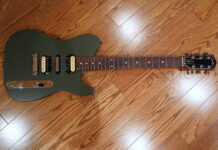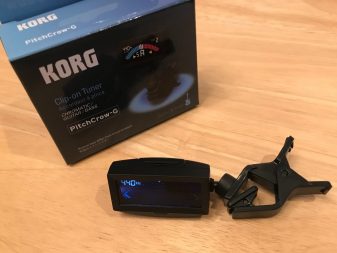 A tuner might not be the most exciting tool to shop for, but its usefulness is undeniable. Although being able to tune your instrument by ear is an important skill, it’s often good to check your tuning with a proper reference. Even if you have been playing for many years, this type of reference can save you time and possibly frustration in a recording environment. While pedal-style tuners are quite popular amongst guitarists and bassists, clip-on tuners have gained popularity these past years. They are an elegant solution to tuning and can be quite handy. Korg is a well-known manufacturer that has been building tuners for decades now. Their most recent product, the PitchCrow-G, is a great option for those seeking a quality, clip-on tuner.
A tuner might not be the most exciting tool to shop for, but its usefulness is undeniable. Although being able to tune your instrument by ear is an important skill, it’s often good to check your tuning with a proper reference. Even if you have been playing for many years, this type of reference can save you time and possibly frustration in a recording environment. While pedal-style tuners are quite popular amongst guitarists and bassists, clip-on tuners have gained popularity these past years. They are an elegant solution to tuning and can be quite handy. Korg is a well-known manufacturer that has been building tuners for decades now. Their most recent product, the PitchCrow-G, is a great option for those seeking a quality, clip-on tuner.
I’ve filmed a short video describing the PitchCrow-G and demonstrating how to use it.
A great set of features
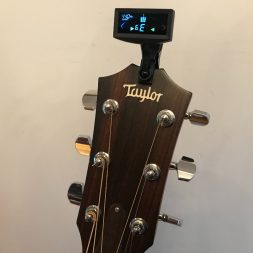 First of all, the PitchCrow-G is a clip-on tuner. You simply attach it to the headstock of your instrument. Through the vibrations of the neck, it will recognize the pitch of whatever note you are playing. This will help you set the string to perfectly match the tension to the note you are tuning to.
First of all, the PitchCrow-G is a clip-on tuner. You simply attach it to the headstock of your instrument. Through the vibrations of the neck, it will recognize the pitch of whatever note you are playing. This will help you set the string to perfectly match the tension to the note you are tuning to.
The screen is fully coloured and brightly lit. It’s hard to imagine a situation where it would be hard to read. It shows you all the information you need to accurately tune your instrument. This includes directional arrows, a pitch gauge and frequency reference (if you need it). The display rotates in all directions to easily set it up for comfortable use.
There are several modes including Guitar, Bass, and chromatic. More experienced players might simply set it to chromatic and work from there. The other two modes are great for beginners to learn the proper standard tunings for their instruments. Also, there is a warning for over-winding the first string. This sometimes happens when a student starts winding the string in the wrong direction, and it can lead to a string break.
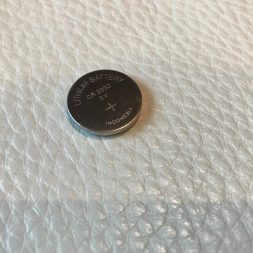 The accuracy is very fine and goes to 0.1 cents. That’s a thousandth of a semitone. Considering the fact that people rarely perceive a difference of 5 cents and less, this tuner is more than accurate for all situations. It is powered by a single CR2032 lithium battery, for which Korg promises 24 hours of continuous use.
The accuracy is very fine and goes to 0.1 cents. That’s a thousandth of a semitone. Considering the fact that people rarely perceive a difference of 5 cents and less, this tuner is more than accurate for all situations. It is powered by a single CR2032 lithium battery, for which Korg promises 24 hours of continuous use.
Easy tuning and visibility
I had absolutely no problems or complaints using the PitchCrow-G. The screen is very easy to read, thanks to bright indicators. This is ideal for dark stages. Since it works through vibrations, tuning is subtle and does not interfere with the show. Also, I don’t imagine visibility being a problem during sunny days.
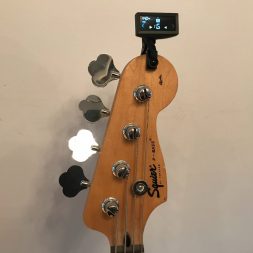 While I simply tune in chromatic mode, I explored the Guitar and Bass modes. These are very simple to use, and the PitchCrow-G will recognize which string you are trying to tune. This is great for beginners who still might be confused by the order of the notes and might possibly over-tighten a string.
While I simply tune in chromatic mode, I explored the Guitar and Bass modes. These are very simple to use, and the PitchCrow-G will recognize which string you are trying to tune. This is great for beginners who still might be confused by the order of the notes and might possibly over-tighten a string.
These modes also enable you to add up to 5 flats, enabling alternate tunings (but still following the standard order of notes). A capo mode also lets you do this for up to 7 semitones higher.
You can also adjust the reference adjustment to tune to a different frequency. This is slightly niche, but I would use it constantly when I would play with a pianist and tune to the piano’s height. Since instruments constantly fluctuate in tuning, it’s a good way to make sure you are in tune with an instrument that’s much harder to tune. I would simply play a note and get the tuner to show a perfectly tuned reference note by adjusting the frequency reference, if need be. This is a simple way of making sure that everything sounds nice and consistent.
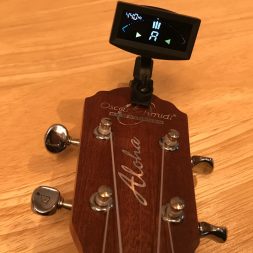 I see this model as a perfect accessory for beginners. Its user-friendly modes are a great introduction to proper tuning. The chromatic mode is there to accommodate more experienced users and those that wish to explore alternate tunings. Also, for professionals that like the clip-on format, this is a stage-ready product, thanks to accurate tuning and a very clear screen. Its compact size is also quite elegant and won’t distract you or the audience from what’s important: a well-tuned performance.
I see this model as a perfect accessory for beginners. Its user-friendly modes are a great introduction to proper tuning. The chromatic mode is there to accommodate more experienced users and those that wish to explore alternate tunings. Also, for professionals that like the clip-on format, this is a stage-ready product, thanks to accurate tuning and a very clear screen. Its compact size is also quite elegant and won’t distract you or the audience from what’s important: a well-tuned performance.
A word About tuning fretted instruments
While we are on the subject of tuning, I would like to address an issue that is sometimes overlooked by guitarists and bassists. We spend a lot of time playing with the tuning pegs to make sure our open strings are correctly in tune, but this is only a small part of the battle.
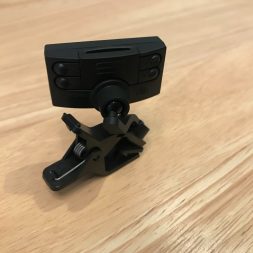 Fretted instruments are equally tempered, which means that every consecutive fret’s frequency has to increase with a 1/12th of an octave jump. Once you reach that octave, it is said that the instrument is well intonated if that frequency is exactly double of the one of the open string. If the length of the string isn’t correct, the frets will not fall under the right spot of string. If that’s the case, no matter how spot on you are on the tuning of that open string, your guitar or bass will be out of tune, not only on the same string, but between strings also.
Fretted instruments are equally tempered, which means that every consecutive fret’s frequency has to increase with a 1/12th of an octave jump. Once you reach that octave, it is said that the instrument is well intonated if that frequency is exactly double of the one of the open string. If the length of the string isn’t correct, the frets will not fall under the right spot of string. If that’s the case, no matter how spot on you are on the tuning of that open string, your guitar or bass will be out of tune, not only on the same string, but between strings also.
Every string on your fretted instrument is adjustable. On an electric instrument, this correction is easy to do and doesn’t go out of whack often. That being said, it’s necessary for a good sounding instrument. You can readily learn to do it by yourself thanks to many references on the internet. You’ll only need the appropriate screwdriver for your type of instrument, and a tuner. This is where the PitchCrow-G’s accuracy is very appreciated.
If you feel uneasy about working on your instrument, there are many luthiers available. They will gladly make all the necessary adjustments for your instrument to be in perfect, in-tune condition. They are also a great reference for any kind of question you might have about the inner-workings of your instrument.
Check out the Korg PitchCrow-G on Best Buy’s website.

